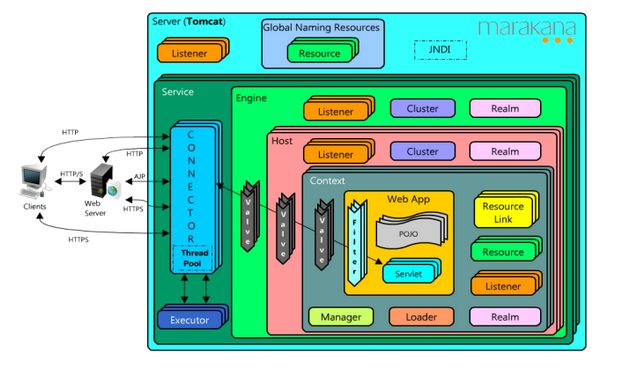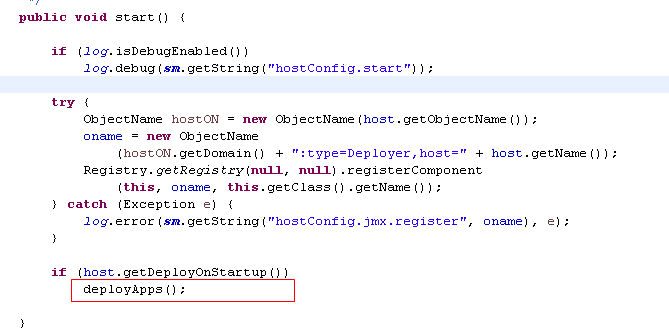Tomcat启动过程都干了啥
Tomcat是一个Web容器,用于接收HTTP请求并作出响应。我们都知道它是使用ServerSocket、Socket使用TCP链接达到通信的目的。但这个过程是如何做到的呢?我们在webapps下放的那些Web应用又是如何被监听起来的呢?配置webApp时有多种配置方式,如何正确的使用它们呢?web.xml为什么要那么配置呢,我们是否可以自定义一些元素呢?
这些都是接下来,我要研究的课题。在此之前,我们还是先让Tomcat能够启动起来吧。
在了解Tomcat启动过程之前,最好还是上网查查Tomcat有哪些顶层的接口,也就是Tomcat的设计架构,不然晕着头就去调试代码,是看不出什么来的。
通过网上的了解,知道了Tomcat主要的接口有:
·Server、Service、Container、Connector、Lifecycle、Executor、Engine
、Host、Context、Wrapper、Value以及他们之间的关系。
其他的:
Realm、MBean等等。
紧接着大致的浏览了一下这些顶级接口,以及他们之间的关系,画了一张类图,如下:
通过这个类图,就可以快速的了解这些主要接口之间的关系了。
接下来,开始Tomcat启动过程的源码调试,如何启动调试,上一浓ky"http://www.it165.net/qq/" target="_blank" class="keylink">qqyqc7E0tG+rcu1tcS63Mfls/7By6GjPC9wPgo8cD6198rUyrGjrMjrv9rU2kJvb3RzdHJhcCNtYWluKCk8L3A+Cgo8aW1nIGlkPQ=="code_img_closed_4ad30836-8149-461d-8988-f83a0261708c" class="code_img_closed" src="http://www.it165.net/uploadfile/files/2014/0928/2014092818483481.gif" alt="" />
public static void main(String args[]) {
if (daemon == null) {
daemon = new Bootstrap();
try {
// 初始化守护进程,其实就是初始化类加载器
daemon.init();
} catch (Throwable t) {
t.printStackTrace();
return;
}
}
try {
String command = "start";
if (args.length > 0) {
command = args[args.length - 1];
}
if (command.equals("startd")) {
args[args.length - 1] = "start";
daemon.load(args);
daemon.start();
} else if (command.equals("stopd")) {
args[args.length - 1] = "stop";
daemon.stop();
} else if (command.equals("start")) {
daemon.setAwait(true);
// 加载相关配置文件,初始化几个主要的顶层接口实例
daemon.load(args);
// 启动那些有生命周期的顶层实例,监听用户请求
daemon.start();
} else if (command.equals("stop")) {
daemon.stopServer(args);
} else {
log.warn("Bootstrap: command \"" + command + "\" does not exist.");
}
} catch (Throwable t) {
t.printStackTrace();
}
}从这个方法看,Tomcat启动过程可以简化为3个步骤:
1)初始化守护进程,其实就是初始化类加载器
2)加载相关配置文件,初始化几个主要的顶层接口实例,简单了说,就是服务器初始化。
3)启动那些有生命周期的顶层实例,监听用户请求,简单了说,就是启动服务器。
接下来,就针对这三个过程分别说明:
1、初始化类加载器
public void init()
throws Exception
{
// Set Catalina path
// 根据环境变量CATALINA_HOME来初始化Tomcat的安装路径,相关配置文件路径
setCatalinaHome();
setCatalinaBase();
// 初始化类加载器,用于加载tomcat/lib目录下的jar包和class文件,或者从网络上加载class文件。
initClassLoaders();
Thread.currentThread().setContextClassLoader(catalinaLoader);
// 从tomcat/lib目录下加载org.apache.catalina.startup.Catalina类
// 用于开启Tomcat的真正的启动过程
SecurityClassLoad.securityClassLoad(catalinaLoader);
// Load our startup class and call its process() method
if (log.isDebugEnabled())
log.debug("Loading startup class");
Class startupClass =
catalinaLoader.loadClass
("org.apache.catalina.startup.Catalina");
Object startupInstance = startupClass.newInstance();
// Set the shared extensions class loader
if (log.isDebugEnabled())
log.debug("Setting startup class properties");
String methodName = "setParentClassLoader";
Class paramTypes[] = new Class[1];
paramTypes[0] = Class.forName("java.lang.ClassLoader");
Object paramValues[] = new Object[1];
paramValues[0] = sharedLoader;
Method method =
startupInstance.getClass().getMethod(methodName, paramTypes);
method.invoke(startupInstance, paramValues);
catalinaDaemon = startupInstance;
}Tomcat官方描述这个过程
类加载器初始化过程到这里也介绍完毕了,这里贴出来Tomcat官方文档中是如何介绍这个过程的:
2、服务器初始化
在调试这个过程之前,最好先了解一下配置文件server.xml如何配置,各个部分代表什么,下面是讲tomcat默认的server.xml写下来了。
代码调试:
1)加载server.xml,并创建出那些顶层对象
public void load() {
// 设置初始化开始时间,用于最后统计初始化过程用了多长时间
long t1 = System.nanoTime();
// 这一步是再次初始化Tomcat的安装目录等
initDirs();
// Before digester - it may be needed
initNaming();
// 这是一个XML文档解析器,用于解析server.xml、server-embed.xml
// Create and execute our Digester
Digester digester = createStartDigester();
InputSource inputSource = null;
InputStream inputStream = null;
File file = null;
try {
// file就是server.xml
file = configFile();
inputStream = new FileInputStream(file);
inputSource = new InputSource("file://" + file.getAbsolutePath());
} catch (Exception e) {
;
}
if (inputStream == null) {
try {
inputStream = getClass().getClassLoader()
.getResourceAsStream(getConfigFile());
inputSource = new InputSource
(getClass().getClassLoader()
.getResource(getConfigFile()).toString());
} catch (Exception e) {
;
}
}
// This should be included in catalina.jar
// Alternative: don't bother with xml, just create it manually.
// 当tomcat作为一个独立的应用服务器是解析server.xml
// 当tomcat嵌入到其他应用中时,解析server-embed.xml
if( inputStream==null ) {
try {
inputStream = getClass().getClassLoader()
.getResourceAsStream("server-embed.xml");
inputSource = new InputSource
(getClass().getClassLoader()
.getResource("server-embed.xml").toString());
} catch (Exception e) {
;
}
}
if ((inputStream == null) && (file != null)) {
log.warn("Can't load server.xml from " + file.getAbsolutePath());
if (file.exists() && !file.canRead()) {
log.warn("Permissions incorrect, read permission is not allowed on the file.");
}
return;
}
// 配置文件解析,解析的过程中,就会根据配置文件中的 例如server.xml中有
与这些元素相关的顶层对象都会被创建。这些对象创建完毕,并且也设置依赖完毕,但是Tomcat并不知道一样,需要将他们都注册一下。
2)初始化Server对象:注册Server对象
接下来看看Server真正的初始化过程。
StandardServer#initialize():
public void initialize()
throws LifecycleException
{
if (initialized) {
log.info(sm.getString("standardServer.initialize.initialized"));
return;
}
lifecycle.fireLifecycleEvent(INIT_EVENT, null);
initialized = true;
// Server对象已经创建完毕了,现在将作为Tomcat组件其注册
if( oname==null ) {
try {
oname=new ObjectName( "Catalina:type=Server");
Registry.getRegistry(null, null)
.registerComponent(this, oname, null );
} catch (Exception e) {
log.error("Error registering ",e);
}
}
// Register global String cache
try {
ObjectName oname2 =
new ObjectName(oname.getDomain() + ":type=StringCache");
Registry.getRegistry(null, null)
.registerComponent(new StringCache(), oname2, null );
} catch (Exception e) {
log.error("Error registering ",e);
}
// Initialize our defined Services
// 在Server下设置初始化多个service,这个依据server.xml中的
3)初始化Service对象:注册 Services、executors对象
StandardService#initialize():
public void initialize()
throws LifecycleException
{
// Service shouldn't be used with embeded, so it doesn't matter
if (initialized) {
if(log.isInfoEnabled())
log.info(sm.getString("standardService.initialize.initialized"));
return;
}
initialized = true;
if( oname==null ) {
try {
// Hack - Server should be deprecated...
Container engine=this.getContainer();
domain=engine.getName();
// 注册Service
oname=new ObjectName(domain + ":type=Service,serviceName="+name);
this.controller=oname;
Registry.getRegistry(null, null)
.registerComponent(this, oname, null);
// 设置service的executors属性并注册executors
Executor[] executors = findExecutors();
for (int i = 0; i < executors.length; i++) {
ObjectName executorObjectName =
new ObjectName(domain + ":type=Executor,name=" + executors[i].getName());
Registry.getRegistry(null, null)
.registerComponent(executors[i], executorObjectName, null);
}
} catch (Exception e) {
log.error(sm.getString("standardService.register.failed",domain),e);
}
}
if( server==null ) {
// Register with the server
// HACK: ServerFactory should be removed...
ServerFactory.getServer().addService(this);
}
// Initialize our defined Connectors
// 在service下设置多个connector
// 这个要依据service.xml的
synchronized (connectors) {
for (int i = 0; i < connectors.length; i++) {
try {
connectors[i].initialize();
} catch (Exception e) {
String message = sm.getString(
"standardService.connector.initFailed",
connectors[i]);
log.error(message, e);
if (Boolean.getBoolean("org.apache.catalina.startup.EXIT_ON_INIT_FAILURE"))
throw new LifecycleException(message);
}
}
}
} 4)初始化Connector对象
public void initialize()
throws LifecycleException
{
if (initialized) {
if(log.isInfoEnabled())
log.info(sm.getString("coyoteConnector.alreadyInitialized"));
return;
}
this.initialized = true;
if( oname == null && (container instanceof StandardEngine)) {
try {
// 注册连接器Connector
StandardEngine cb=(StandardEngine)container;
oname = createObjectName(cb.getName(), "Connector");
Registry.getRegistry(null, null)
.registerComponent(this, oname, null);
controller=oname;
} catch (Exception e) {
log.error( "Error registering connector ", e);
}
if(log.isDebugEnabled())
log.debug("Creating name for connector " + oname);
}
// 为当前Connector创建一个CoyoteAdapter适配器
adapter = new CoyoteAdapter(this);
protocolHandler.setAdapter(adapter);
// Make sure parseBodyMethodsSet has a default
if( null == parseBodyMethodsSet )
setParseBodyMethods(getParseBodyMethods());
IntrospectionUtils.setProperty(protocolHandler, "jkHome",
System.getProperty("catalina.base"));
try {
// 协议初始化
protocolHandler.init();
} catch (Exception e) {
throw new LifecycleException
(sm.getString
("coyoteConnector.protocolHandlerInitializationFailed", e));
}
}
5)ProtocolHandler初始化
协议初始化,根据
public void init() throws Exception {
endpoint.setName(getName());
endpoint.setHandler(cHandler);
// Verify the validity of the configured socket factory
try {
if (isSSLEnabled()) {
sslImplementation =
SSLImplementation.getInstance(sslImplementationName);
socketFactory = sslImplementation.getServerSocketFactory();
endpoint.setServerSocketFactory(socketFactory);
} else if (socketFactoryName != null) {
socketFactory = (ServerSocketFactory) Class.forName(socketFactoryName).newInstance();
endpoint.setServerSocketFactory(socketFactory);
}
} catch (Exception ex) {
log.error(sm.getString("http11protocol.socketfactory.initerror"),
ex);
throw ex;
}
if (socketFactory!=null) {
Iterator attE = attributes.keySet().iterator();
while( attE.hasNext() ) {
String key = attE.next();
Object v=attributes.get(key);
socketFactory.setAttribute(key, v);
}
}
// endpoint初始化,根据上面的类图就知道,当协议确定时,Endpoint的类型也就确定了。
try {
endpoint.init();
} catch (Exception ex) {
log.error(sm.getString("http11protocol.endpoint.initerror"), ex);
throw ex;
}
if (log.isInfoEnabled())
log.info(sm.getString("http11protocol.init", getName()));
}
6)Endpoint初始化
public void init()
throws Exception {
if (initialized)
return;
// Initialize thread count defaults for acceptor
if (acceptorThreadCount == 0) {
acceptorThreadCount = 1;
}
if (serverSocketFactory == null) {
serverSocketFactory = ServerSocketFactory.getDefault();
}
if (serverSocket == null) {
try {
if (address == null) {
serverSocket = serverSocketFactory.createSocket(port, backlog);
} else {
serverSocket = serverSocketFactory.createSocket(port, backlog, address);
}
} catch (BindException orig) {
String msg;
if (address == null)
msg = orig.getMessage() + " :" + port;
else
msg = orig.getMessage() + " " +
address.toString() + ":" + port;
BindException be = new BindException(msg);
be.initCause(orig);
throw be;
}
}
//if( serverTimeout >= 0 )
// serverSocket.setSoTimeout( serverTimeout );
initialized = true;
} 从这段代码很清楚的看出,Endpoint就代表了服务端的一个Socket端点,endpoint的初始化其实就是创建ServerSocket对象。
上述6个步骤中,不论采用什么协议,前3步都是一样的,至于5)、6)两步要也是需要的,但是由于协议的不同,每一步的内部是如何实现的,这点并不一样。
Tomcat官方描述这个过程
到这里,服务器初始化也就介绍的差不多了。这里贴出来tomcat官方文档时如何描述这一过程的:
3、服务器开启
StandardService启动过程说明
可以通过查看StandardServer#start()来了解服务器开启的过程。
如果跟踪代码就会发现:
Catalina#start()--àStandardServer#start()--àStandardService#start()
也就是Catalina对象执行start()期间,会调用StandardServer对象的start()方法。
StandardServer对象执行start()期间,会调用Server下的所有的StandardService对象的start()。
下面就看看StandardService对象的start方法:
public void start() throws LifecycleException {
// Validate and update our current component state
if (started) {
if (log.isInfoEnabled()) {
log.info(sm.getString("standardService.start.started"));
}
return;
}
if( ! initialized )
init();
// Notify our interested LifecycleListeners
lifecycle.fireLifecycleEvent(BEFORE_START_EVENT, null);
if(log.isInfoEnabled())
log.info(sm.getString("standardService.start.name", this.name));
lifecycle.fireLifecycleEvent(START_EVENT, null);
started = true;
// 启动定义的所有的容器
// Engine、Host、Context都是容器,只要在server.xml中定义了,都会在这里启动
if (container != null) {
synchronized (container) {
if (container instanceof Lifecycle) {
((Lifecycle) container).start();
}
}
}
// 启动执行器Executor
synchronized (executors) {
for ( int i=0; i
Service下的Container的启动过程说明
Service下的容器有Engine,Engine下的容器有Host,Host下的容器有Context。
每个容器下都有Pipeline、Value、Realm等等配置。
接下来就看看如何启动这些各个容器的。调试代码的过程中,就会发现,每个容器都会使用到的一个方法是在ContainerBase中定义的start():
public synchronized void start() throws LifecycleException {
// Validate and update our current component state
if (started) {
if(log.isInfoEnabled())
log.info(sm.getString("containerBase.alreadyStarted", logName()));
return;
}
// Notify our interested LifecycleListeners
lifecycle.fireLifecycleEvent(BEFORE_START_EVENT, null);
started = true;
// Start our subordinate components, if any
if ((loader != null) && (loader instanceof Lifecycle))
((Lifecycle) loader).start();
logger = null;
getLogger();
if ((logger != null) && (logger instanceof Lifecycle))
((Lifecycle) logger).start();
if ((manager != null) && (manager instanceof Lifecycle))
((Lifecycle) manager).start();
if ((cluster != null) && (cluster instanceof Lifecycle))
((Lifecycle) cluster).start();
if ((realm != null) && (realm instanceof Lifecycle))
((Lifecycle) realm).start();
if ((resources != null) && (resources instanceof Lifecycle))
((Lifecycle) resources).start();
// Start our child containers, if any
// 启动子容器,也就是说:
如果this是Engine对象,就会启动Engine下的所有的host来启动。
// 当host执行start()过程,也会执行这个方法,来启动host下的context。
// 也就是说,这里会引起递归调用
Container children[] = findChildren();
for (int i = 0; i < children.length; i++) {
if (children[i] instanceof Lifecycle)
((Lifecycle) children[i]).start();
}
// Start the Valves in our pipeline (including the basic), if any
// 启动Container下的在pipeline中的value
if (pipeline instanceof Lifecycle)
((Lifecycle) pipeline).start();
// Notify our interested LifecycleListeners
lifecycle.fireLifecycleEvent(START_EVENT, null);
// 启动守护线程,用于周期性的检查Session是否超时
// Start our thread
threadStart();
// Notify our interested LifecycleListeners
lifecycle.fireLifecycleEvent(AFTER_START_EVENT, null);
}1)StandardEngine启动过程
public void start() throws LifecycleException {
if( started ) {
return;
}
// 在初始化阶段,并没有初始化容器,所以在启动容器前要先初始化
if( !initialized ) {
// 容器的初始化和其他组件的初始化类似,都是将其注册为MBean
init();
}
// Look for a realm - that may have been configured earlier.
// If the realm is added after context - it'll set itself.
if( realm == null ) {
ObjectName realmName=null;
try {
realmName=new ObjectName( domain + ":type=Realm");
if( mserver.isRegistered(realmName ) ) {
mserver.invoke(realmName, "init",
new Object[] {},
new String[] {}
);
}
} catch( Throwable t ) {
log.debug("No realm for this engine " + realmName);
}
}
// Log our server identification information
//System.out.println(ServerInfo.getServerInfo());
if(log.isInfoEnabled())
log.info( "Starting Servlet Engine: " + ServerInfo.getServerInfo());
if( mbeans != null ) {
try {
Registry.getRegistry(null, null)
.invoke(mbeans, "start", false);
} catch (Exception e) {
log.error("Error in start() for " + mbeansFile, e);
}
}
// Standard container startup
// 这才是真正的操作。而这个操作是在ContainerBase中定义的,也就是说,所有的Container都可以使用。这个方法上面已经说明。
super.start();
}2)StandardHost启动过程
public synchronized void start() throws LifecycleException {
if( started ) {
return;
}
// 初始化host
if( ! initialized )
init();
// Look for a realm - that may have been configured earlier.
// If the realm is added after context - it'll set itself.
if( realm == null ) {
ObjectName realmName=null;
try {
realmName=new ObjectName( domain + ":type=Realm,host=" + getName());
if( mserver.isRegistered(realmName ) ) {
mserver.invoke(realmName, "init",
new Object[] {},
new String[] {}
);
}
} catch( Throwable t ) {
log.debug("No realm for this host " + realmName);
}
}
// Set error report valve, 用于报请求HTML错误码
if ((errorReportValveClass != null)
&& (!errorReportValveClass.equals(""))) {
try {
boolean found = false;
if(errorReportValveObjectName != null) {
ObjectName[] names =
// 添加Value,然后在下面的代码super.start()使用;也就是在调用ContainerBase#start()中使用。
((StandardPipeline)pipeline).getValveObjectNames();
for (int i=0; !found && i
2.1)Host启动过程中的管道pipeline启动
上面说了容器启动过程中都会执行的方法:ContainerBase#start(),代码在上面。代码中有一个pipeline.start()语句。
public synchronized void start() throws LifecycleException {
// Validate and update our current component state
if (started)
throw new LifecycleException
(sm.getString("standardPipeline.alreadyStarted"));
// Notify our interested LifecycleListeners
lifecycle.fireLifecycleEvent(BEFORE_START_EVENT, null);
started = true;
// Start the Valves in our pipeline (including the basic), if any
Valve current = first;
if (current == null) {
current = basic;
}
while (current != null) {
if (current instanceof Lifecycle)
((Lifecycle) current).start();
registerValve(current);
current = current.getNext();
}
// Notify our interested LifecycleListeners
lifecycle.fireLifecycleEvent(START_EVENT, null);
// Notify our interested LifecycleListeners
// 通知监听器执行相关处理
lifecycle.fireLifecycleEvent(AFTER_START_EVENT, null);
}2.2)通过事件处理进入到应用程序部署阶段
在fireLifecycleEvent方法调用期间,会调用到HostConfig的处理。
从这里就进入了应用程序部署的阶段了。
这个方法中的setDeployXML用于设置部署时是否部署XML,
也就是否部署通过XML方式描述的上下文:
setUnpackWars()是设置是否部署webapps下的war包。
HostConfig#start():
部署Host下所有的Web应用。
2.3)开始部署应用程序
从这个方法来看,部署时:
1)穴ky"http://www.it165.net/qq/" target="_blank" class="keylink">qqyv8rwdG9tY2F0L2NvbmbPwrWxx7BFbmdpbmWjqGNhdGFsaW5ho6nPwrXEtbHHsGhvc3SjqGxvY2FsaG9zdKOpxL/CvM/CtcTL+dPQtcR4bWzOxLz+oaPV4sDvtcRYTUzOxLz+vs3Kx9K7uPZjb250ZXh0w+jK9rf7oaM8L3A+CjxwPjIpu+Gyv8rwdG9tY2F0L3dlYmFwcHPPwrXEd2FysPy6zcS/wryhozwvcD4KCjxwPrb4w7/W1rK7zazA4NDNtcTTptPDysfI57rOsr/K8LW9aG9zdM/CtcSjrNXiwO++zc/Isru/tMHLoaM8L3A+Cgo8cD7WwbTLo6xUb21jYXTG9LavtcTV+7j2wfezzKOsy+PKx8HLveK1xLLusru24MHLoaM8L3A+Cgo8aDM+VG9tY2F0udm3vcPoyvbV4rj2uf2zzDwvaDM+CjxwPtTa1eLA76Os0rLM+bP2wLRUb21jYXS52be9zsS1tcqxyOe6zsPoyvbV4tK7uf2zzLXEo7o8L3A+CjxwPiZuYnNwOzxpbWcgc3JjPQ=="http://www.it165.net/uploadfile/files/2014/0928/2014092818483590.png" alt="" />
我在调试时写的流程是和官方的文档是基本上吻合的。通过这个调试,很容易就知道了Tomcat的各个组件的关系。








